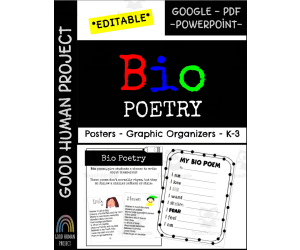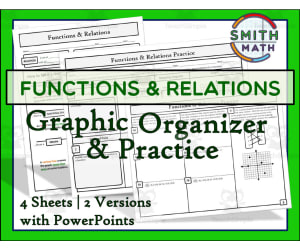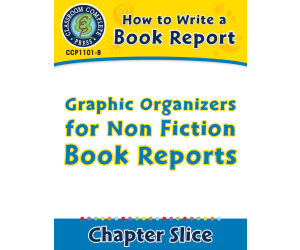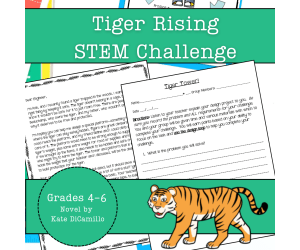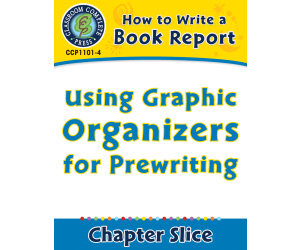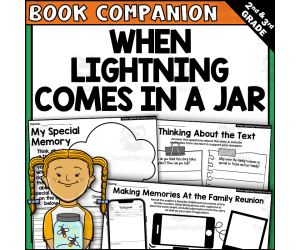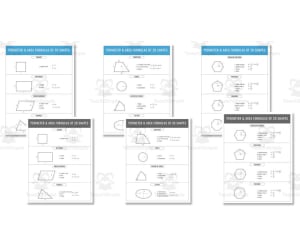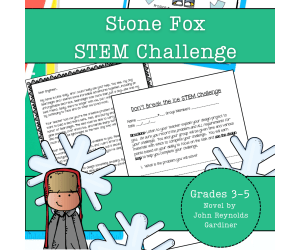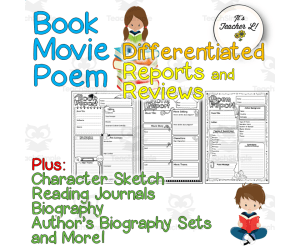5,827 products added recently
Page 2 - Popular Graphic Organizers
Discover a selection of popular graphic organizers suitable for a variety of subjects and grade levels. These versatile tools assist students in structuring information, planning essays, and summarizing content. Utilize these organizers to support critical thinking and improve educational outcomes in your classroom.
Bio Poetry Writing | Posters & Graphic Organizers
ELA, Literature, Poetry, Grade 1, 2, 3, Graphic Organizers, Teacher Tools
This resource is a set of templates for bio poem writing. This pairs well with your poetry unit in English class. You may also love to print these off and use in a center activity. This resource can be accessed through: PowerPoint Google slides PDF
Author Good Human Project
Tags Bio Poems, Poetry Lesson, Poetry Writing, Graphic Organizers, Posters
Storyboard Creative Writing Planning Guide
ELA, Writing, Creative Writing, Grade 4, 5, 6, 7, Teacher Tools, Graphic Organizers
This resource is a Storyboard Creative Writing Planning Guide. This resource can be accessed digitally or as a printable. Included are 9 interactive Google Slides to make the writing process engaging and effective all year long.
Author The Language of Learning
Tags Creative Writing, Graphic Organizers, Storyboard, Story Elements, Planning Guide
Quad Graphic Organizer Bundle
Math, Algebra, Geometry, Grade 9, 10, 11, 12, Graphic Organizers, Teacher Tools
This is a Quad Graphic Organizer Bundle for your math students. This resource is split up into groups. Each group contains the following resources: Group 1 based on Exclusive Definitions • Definitions & Theorems Graphic Organizers • Classification Summary Sheet • Classification Bingo Game Group 2 based on Inclusive Definitions • Definitions & Theorems Graphic Organizers • Classification Summary Sheet • Classification Bingo Game Suggested Use I personally only teach the Exclusive Definitions per our curriculum. However, I know some schools teach Inclusive Definitions, and others teach both in order to compare them. This resource allows for all three options, depending on school requirements and teacher preference. Exclusive vs. Inclusive There are two basic systems used to define quadrilaterals: Exclusive and Inclusive. These two systems have many similarities, but they also have key differences. These differences involve 3 definition changes as summarized in the table included. I hope you enjoy! You can find more resources at my storefront here: https://teachsimple.com/contributor/smith-math Here are other similar resources for you to enjoy: https://teachsimple.com/product/intro-to-calculus-word-wall https://teachsimple.com/product/laws-of-exponents-lessons-intro-lesson-exponents-basics https://teachsimple.com/product/sequences-and-series-graphic-organizer https://teachsimple.com/product/arkansas-river-float-activity https://teachsimple.com/product/systems-of-equations-graphic-organizer-packet https://teachsimple.com/product/algebra-2-word-wall
Author Smith Math
Tags Quad Graphic Organizers, Summary Sheets, Math Bundle, Geometry Bundle, Math Bingo, Classifications, Exclusive Definition, Smith Math, Quad Graphics Columbus
Functions & Relations Graphic Organizer and Practice Packet
Math, Algebra, Graphing, Grade 10, 11, 12, Graphic Organizers, Teacher Tools
If you are a high school math teacher, finding resources that best serve for your students is of the utmost importance! This is a Functions & Relations Graphic Organizer and Practice Packet that is filled with purposeful information that your students can put to use right away. Graphic organizers have always been a great way to organize information, so these are no exception! There are 4 sheets included and 2 different versions. You will get a completed version that is completely filled out and a student version with blanks for students to fill in. You will also get an editable version that you can open in PowerPoint or Google Slides if you want students to complete it digitally. Information included on the Functions & Relations Graphic Organizer: 1. Relation Definition 2. Function Definition 3. How to tell if a relation is NOT a function… …from a set of Ordered Pairs …from a Mapping Diagram …from a Graph There will also be a 3-page practice worksheet with 7 problems for students to complete. An answer key is included. I hope you enjoy! Here are similar resources for you to enjoy: https://teachsimple.com/product/arkansas-river-float-activity https://teachsimple.com/product/fill-the-tank-activity https://teachsimple.com/product/algebra-2-word-wall https://teachsimple.com/product/intro-to-calculus-word-wall You can visit my storefront here: https://teachsimple.com/contributor/smith-math I can be contacted for questions and concerns at smithmathtpt@gmail.com .
Author Smith Math
Tags Functions, Relations, Algebra Graphic Organizer, Homework, Vocabulary Terms, Tables, Graphs, Mapping Diagram, Ordered Pairs
"Zane and the Hurricane" Novel Study Reader Response Questions Packet
ELA, Reading, Reading Comprehension, Literature, Grade 4, 5, 6, Worksheets & Printables, Novel Studies, Teacher Tools, Graphic Organizers, Activities, Assessments, Worksheets
This 37-page printable reader response packet is a supplemental resource for the novel "Zane and the Hurricane" by Rodman Philbrick. The reader response questions, organized into chapters, are intended to challenge students to use higher-level thinking skills and lend themselvesto in-depth class or peer discussions.The questions require students to provide textual evidence to support their responses and/or express their opinions or perspectives. The graphic organizers provided in this product can be utilized in a variety of ways to differentiate based on your student'sacademic abilities and needs. Students can work on the activities independently, in literature circles, or in book clubs. It's a great resource to help keep students accountable for their reading and comprehension of the text. ⭐️This resource includes:⭐️ ◾Reader Response Journal ◾Cover sheet ◾Short-answer questions for all chapters ◾ character analysis graphic organizer ◾character change graphic organizer ◾character summary graphic organizer ◾sensory language chart (color and B&W) ◾ANSWER KEY ⭐ You may also like: ⭐ ◾ "Zane and the Hurricane Essay Questions and Writing Prompts ◾ "Zane and the Hurricane Novel Study Theme Activities ◾ "Zane and the Hurricane Novel Study Chapter Quizzes ◾ "Zane and the Hurricane" Novel Study Reader Response Questions and Activities Be sure to check out my storefront here: https://teachsimple.com/contributor/creatively-gifted
Author Creatively Gifted
Tags Literature, Literature Circles, Zane And The Hurricane, Reader Response, Open-ended Questions, Character Analysis, Story Summary, Homework, Reader Response Questions Middle School
How to Write a Book Report: Graphic Organizers for Non Fiction Book Reports
ELA, Writing, Common Core, Grade 5, 6, 7, 8, Graphic Organizers, Teacher Tools
How to Write a Book Report: Graphic Organizers for Non Fiction Book Reports This teaching resource is an all-in-one solution aimed at engaging both educators and students in the challenging yet exciting endeavor of non-fiction book report writing. Within this comprehensive, 24-page PDF, you'll find all the required tools for helping students in Grades 5 through 8. The Challenge of Teaching Book Reports Writing Tutors may find it daunting to instruct their pupils on how to craft an efficient book report, and such difficulty tends to increase when dealing with non-fiction content. This instructional tool addresses these concerns directly by furnishing step-by-step guidance supplemented with striking graphic organizers. Focusing on Effective Organization and Presentation This resource concentrates on providing learners with concrete methodologies for collating and displaying information about various non-fiction topics encountered during language arts and writing lessons. Teachers can take advantage of these robust tools to facilitate their students' grasp of organized data management during pre-writing stages. Pupil-Efficient Instructions: The teaching aid combats overcomplicated tasks, presenting clear guidance, inclusive of student assessment rubrics and comprehension quizzes promoting seamless understanding among learners. Bloom’s Taxonomy-Based Objectives: Learning goals follow the globally acclaimed Bloom’s Taxonomy framework encouraging advanced cognition as per current educational standards, aligning perfectly with Common Core State Standards. Vocabulary Skill Reinforcement: Ready-to-use word puzzles serve as entertaining interludes while amplifying vocabulary learnt from textbooks, infusing an air of fun into learning activities without compromising educational guidelines. Potential Use Cases across Classroom Activities Educators can choose from multitude options regarding this tool's application. It can be used in numerous techniques ranging from whole-class instructions to small group discussions, outside classroom activities and even individual self-pacing exercises! Concluding Thoughts In essence, tutors seeking engaging methodologies to instruct non-fiction book report writing will find immense value in this aid. The perfect blend of explicit teaching, captivating graphic organizers and extensive student guides makes it a crucial addition to any toolkit. Applying such resource promises simplified yet systematic learning experiences ensuring efficiency at mastering non-fiction book reporting skills.
Author Classroom Complete Press
Tags Language Arts, Writing, Writing A Book Report, Non-fiction Test, Graphic Organizers
Tiger Rising STEM Experiment + STEM Project for Grades 4, 5, 6
Science, Technology, Engineering, STEM, Grade 4, 5, 6, Experiments, Activities, Projects, Diagrams, Teacher Tools, Graphic Organizers, Rubrics
This hands-on activity combines creativity and problem-solving as students design and build a tower for the safety of the tiger in the novel, Tiger Rising. Perfect for integrating literature and science, this challenge encourages students to apply engineering principles using simple materials while fostering teamwork and critical thinking. What’s Inside This Resource: Student Letter: A letter from Rob Horton introduces the challenge, linking the story to a real-world engineering task. Design Loop Graphic: A visual students can attach to their science journals, serving as a step-by-step guide throughout the activity. Detailed Instructions: Choose to print the guide as a packet or have students record each stage in their journals for an interactive experience. Teacher Tips: Practical guidance for crafting a clear problem statement with time constraints, materials, and success criteria tailored to your classroom. Skills Your Students Will Build: ✔ Problem-Solving: Identify obstacles and create inventive solutions. ✔ Engineering Design: Navigate the design loop—plan, construct, test, and refine. This page can easily be enlarged for a classroom poster. ✔ Critical Thinking: Assess their prototype’s performance and pinpoint ways to enhance it. ✔ Teamwork: Collaborate effectively to accomplish shared goals. Versatile Classroom Application: Whether as guided instruction or part of an integrated literature and science unit, this STEM activity encourages students to think creatively, document their process, and meet science and engineering standards. The rubric included is based on engineering concepts, but can also be used as a nonfiction writing rubric for cross-curricular options. Why Educators Love This Resource: ⭐ “My students were fully engaged, combining their passion for reading with STEM!” ⭐ “Simple to set up and encourages creativity and teamwork.” ⭐ “A seamless connection between literature and science for cross-curricular learning!” Encourage your students to provide a safe haven for the tiger (and Rob and Sistine?) and experience the excitement of engineering with this standards-aligned STEM adventure!
Author Kel's Klass
Tags 4th Grade Science Project, 4th Grade Science Experiment, 5th Grade Science Project, 5th Grade Science Experiment, 6th Grade Science Project, 6th Grade Science Experiment, Engineering Diagram, Science Graphic Organizer, Science Rubric, Tiger Rising
How to Write a Book Report: Using Graphic Organizers for Prewriting
ELA, Writing, Common Core, Grade 5, 6, 7, 8, Graphic Organizers, Teacher Tools
How to Write a Book Report: Using Graphic Organizers for Prewriting This resource is designed to aid in the education of students, focusing on the organization of thoughts and ideas before they begin writing book reports. Ideal for students between grade 5 and 8, this resource falls squarely within the Language Arts category with an emphasis on enhancing writing skills. The primary function of this tool is to revolutionize the often daunting task of book report assignments by using easily accessible graphic organizers during prewriting. These handy devices guide students through organizing their thoughts concerning key elements such as plot structure, character characteristics, and themes which are essential in creating engaging book reports. A well-organized outline aligns with Bloom's Taxonomy learning objectives; this resource encourages a progressive learning method gliding students gradually from understanding facts through synthesis and evaluation stages - guiding each step along the way to completing polished reports that strictly adhere to proper forms and mechanics. Besides being just a teaching tool, educators can use this resource creatively - whether as supplementary material complementing an ongoing writing program or self-sufficient activities assigned at home. The inclusive package doesn't only include exciting word puzzles enhancing language skills but also comprehension quizzes significantly instrumental in determining student's grasp level over learned concepts. To ensure flawless execution of preset activities included in lesson plans, there’s added reassurance with inclusion of detailed guides breaking down how tasks should be approached. An additional feature includes easy-to-use student assessment rubrics simplifying grading process while ensuring fair basis during marking exercise - offering overall a systemically designed educational experience bundling together both learning and assessment processes neatly organized within one place. Kept flexible via maintaining it available on PDF; it enables usage electronically during virtual classes or printed paper copies accommodating varied class systems from whole group teaching to small group combined studies. This promising writing developmental course for intermediate level students, adheres strictly to the Common Core State Standards and is thoughtfully curated implementing Bloom's Taxonomy techniques forming its fundamental foundation.
Author Classroom Complete Press
Tags PDF
42 Editable Bookmarks for teachers and students - Nature #5
, Not Grade Specific, Teacher Tools, Graphic Organizers
Nature-Themed Editable Bookmarks for Educators This editable bookmark set allows teachers to create customized bookmarks for students. The PowerPoint file includes 42 nature-themed bookmark templates with multiple layouts that can be edited with text, images, and more before printing. These bookmarks can be used for reading incentives, reminders, or student creation. Students will enjoy personalizing bookmarks for themselves, friends, family, and teachers. This adaptable resource is useful for any grade level or subject. Teachers can provide vocabulary words, reading tips, website links, QR codes, or inspiration quotes on the bookmark templates. The possibilities are endless for these editable bookmarks that can be tailored to any educational need and printed year after year. This set offers a creative way for teachers to engage students while encouraging reading.
Author Pick'n Teach
Tags Graphics, Bookmarks, Editable, Nature, Reading
Truman and the Dropping of the Atomic Bomb: Graphic Organizer
Social Studies, History, History: USA, Grade 8, 9, 10, 11, Teacher Tools, Graphic Organizers
Harry S. Truman, the 33rd President of the United States, played a pivotal role in the development and use of atomic bombs during World War II. Truman assumed the presidency on April 12, 1945, following the death of President Franklin D. Roosevelt. At that time, the Manhattan Project , a secret research program focused on developing atomic weapons, was already underway. As President, Truman was faced with a difficult decision regarding the use of atomic bombs against Japan. The Manhattan Project had successfully created two atomic bombs, and Truman had to decide whether to deploy them as a means to end the war. After the war, Truman focused on preventing the spread of nuclear weapons. He supported the creation of the United Nations and played a key role in establishing the Baruch Plan, which proposed international control of atomic energy to prevent further proliferation. Truman's decision to use atomic bombs on Hiroshima and Nagasaki remains one of the most consequential actions of his presidency. It ushered in the nuclear age, shaped the course of history, and sparked ongoing discussions about the use and ethics of atomic weapons. Teacher-prepared notes show students what is important and how ideas relate, and offer a model for how students should take notes themselves (Marzano et al., 2001). This graphic organizer gives students two primary source quotes regarding Truman's use of the bomb. The notes then explain some pro/con arguments about the use of the bomb. Lastly, the notes give students a chance to look at the six immediate effects of the bomb. Comes with a fill-in-the-blank version. Clipart Credit: By PrincePadania
Author Dr. Will Pulgarin
Tags World War II, Truman, Atomic Bomb, Manhattan Project, Japan, Cold War, Graphic Organizer, Pro Con Graphic Organizer
U.S. Government: Gallery Walk of Executive Branch and President's Role
Social Studies, History, History: USA, Government, Grade 8, 9, 10, 11, 12, Teacher Tools, Graphic Organizers, Activities
In this lesson on the US Government: Executive Branch (both Google and Traditional versions are provided), your students will partake in a Gallery Walk activity exploring the multiple "hats" (roles) the US president assumes in the course of his/her duties. The roles explored in this U.S. Government: Gallery Walk of Executive Branch and President's Role include: Commander in Chief, Chief Diplomat, Chief of State, Chief of Party, Chief Citizen, Chief Executive, Chief Legislator, and Chief Administrator. A Gallery Walk activity involves students examining various exhibits akin to a museum, which you place around the classroom. This activity is a dynamic way to present information and encourages physical movement in a structured manner – a refreshing change from conventional lectures! This product includes all necessary Museum Exhibits and corresponding student sheets! **Includes a GOOGLE and Traditional version for your use! About: Learning is a Passion Store - I have taught 6th-12th grade during my 20 year teaching career. I prefer to use lessons in my teaching practice that allow my students to become facilitators and active participants in their own learning rather than merely an audience of "my show". I love to create hands- on, interactive activities that really engage my students in the learning process.
Author Learning is a Passion
Tags Gallery Walk, Government, Executive Branch, President's Roles
Guided Reading Activity The Lemonade War Trifold Book Report
ELA, Reading, Grade 3, 4, 5, Activities, Projects, Teacher Tools, Graphic Organizers, Novel Studies, Worksheets & Printables
The Lemonade War by Jacqueline Davies follows a brother and sister pair, Evan and Jessie, as they compete to see who can earn the most money selling lemonade. While the contest starts as a fun challenge, it brings underlying feelings between the two to the surface, highlighting themes of sibling rivalry and miscommunication. The story emphasizes the importance of family, forgiveness, and understanding one another's strengths and feelings. This trifold resource is created to help students practice reading comprehension skills while providing differentiation for various reading levels. This tool can easily be utilized during guided reading, independent seat work, or literature circles. The included writing wrap-up allows for assessing multiple skills in one project, making it perfect for teachers looking for projects that can cover multiple subjects - reading comprehension, reading skills, and writing. What’s Included in This Resource: Each trifold is broken down by chapters or pages and allows chunking of information for easy teacher planning and appropriate student use. In each trifold, the following skills are assessed: Making Connections: Encourage students to relate the story to their own lives, other texts, and the wider world. Making Inferences: Help students combine text evidence with prior knowledge to draw logical conclusions. Using Context Clues: Teach students to deduce the meaning of unfamiliar words using hints from the text. Visualization: Support students in creating mental images of characters, events, and settings. Evaluation: Develop critical thinking by analyzing characters, themes, and the author’s message. Writing Wrap-Up: A writing assessment tool for reflection and deeper understanding. How This Resource Benefits Teachers: ✔ Provides differentiated instruction for diverse learners. ✔ Fosters text engagement and critical thinking with content. ✔ Offers flexibility for grades, seat work, or group discussions. What Teachers Are Saying: ⭐ "This resource made my guided reading groups more organized and productive!" - Rebecca T. ⭐ "Perfect for differentiation and keeping all students engaged at their level." - Larraine C. ⭐ "My students loved the activities, and it worked seamlessly in our literature circles!" - Celia N.
Author Kel's Klass
Tags Reading Strategies, Trifold Project, Guided Reading, Making Connections, Making Inferences, Context Clues, Evaluating, Visualization, The Lemonade War, Guided Reading Activity
Coloring Pages - Flags of Europe
Geography, Social Studies, Elementary, High School, Middle School, Graphic Organizers, Teacher Tools, Drawing Templates & Outlines, Worksheets & Printables, Worksheets
With more than 750 million inhabitants, Europe is the third most populated continent in the world while being the second smallest, after Australia. It is largely located in the Eastern Hemisphere and all of it is in the Northern Hemisphere. Africa and Asia share the continent of Europe, which is referred to as Afro-Eurasia. Approximately 10.53 million square kilometers (4.06 million square miles) make up the continent of Europe. The Atlantic Ocean borders Europe to the west, and the Arctic Ocean borders Europe to the north. The Mediterranean Sea lies to the south, while the Black Sea, Caspian Sea, and Ural Mountains form its eastern borders. This ebook includes 50 coloring pages with the flags of all countries of Europe. Each coloring page features the name of the country, the original flag in full color, and the flag in black and white line drawing ready to be colored. The countries are presented in alphabetical order.
Author Collaborative Educators
Tags Coloring Pages, Flag, Europe
Guided Reading Activity The Chalkbox Kid Trifold Book Report
ELA, Reading, Grade 2, 3, 4, Projects, Activities, Teacher Tools, Graphic Organizers, Worksheets & Printables, Novel Studies
The Chalk Box Kid by Clyde Robert Bulla tells the story of Gregory, a boy adjusting to a new home, a new school, and a difficult family situation. Feeling out of place, Gregory discovers an abandoned chalk factory where he creates a secret garden with his drawings, allowing his creativity to flourish. Through his art, Gregory finds a sense of belonging and learns that self-expression can bring hope and healing. This trifold activity is created to help students practice reading comprehension skills while providing differentiated instruction for various reading levels. This tool can be used during guided reading, as independent seat work, or within literature circles. The included writing wrap-up allows for assessing multiple skills in one cohesive project, making it an ideal, standards-aligned resource for busy teachers. Grading opportunities for reading comprehension, reading skill work, and writing are available. What’s Included in This Resource: Each trifold is broken into chapters to allow for teacher skill guidance and manageable chunking for student comprehension. Skill Development Activities: Making Connections: Encourage students to relate the story to their own lives, other texts, and the wider world. Making Inferences: Help students combine text evidence with prior knowledge to draw logical conclusions. Using Context Clues: Teach students to deduce the meaning of unfamiliar words using hints from the text. Visualization: Support students in creating mental images of characters, events, and settings. Evaluation: Develop critical thinking by analyzing characters, themes, and the author’s message. Writing Wrap-Up: A creative assessment tool for reflection and deeper understanding. How This Resource Benefits Teachers: ✔ Provides differentiated instruction for diverse learners. ✔ Fosters deeper text engagement and critical thinking. ✔ Offers flexibility for grades, seat work, or group discussions. What Teachers Are Saying: ⭐ "This resource made my guided reading groups more organized and productive!" - Rebecca T. ⭐ "Perfect for differentiation and keeping all students engaged at their level." - Larraine C. ⭐ "My students loved the activities, and it worked seamlessly in our literature circles!" - Celia N.
Author Kel's Klass
Tags Making Inferences, Reading Strategies, Guided Reading Activity, Making Connections, Visualization, Context Clues, Evaluation, Trifold Project, Novel Study, The Chalkbox Kid
10 Graphic Organizers - Comprehension Charts to Review Any Text!
ELA, Reading, Grade 1, 2, 3, Graphic Organizers, Teacher Tools
Comprehension Charts - A Teaching Resource The 10 Graphic Organizers - Comprehension Charts to Review Any Text is a teaching resource designed to strengthen crucial capabilities like understanding and analyzing texts. These visual aids enhance understanding, challenge thinking, and aid comprehension in young learners making it perfect for Grade 1 to Grade 3 students. These focus predominantly on the Language Arts curriculum enriching reading skills. This pack comprises ten diverse designs incorporating different text structures: Author's Purpose Cause and Effect Character, Setting, Events etc. These encourage deep understanding of the read text guiding students to compare contrasting ideas within the texts with Compare and Contrast charts . Breaking down complex readings into manageable parts can be accomplished using: Main Idea and Key Details chart, The Sequence chart for tracing plot progression etc. For intense literature analysis use: Point of View, Problem and Solution charts , which are quite helpful in deciphering advanced readings. Other resources in this package include: Pictorial Storyline graphics for summarizing stories , Moral or message Theme diagrams when discussing fables or short stories . These resources make classroom sessions versatile that can be employed for whole group instruction stimulating brain storming during small group discussions or as individual assignments at home thus reinforcing learnt lessons at school. You can download this teaching tool as a PDF file comprising of 10 pages which are ready for instant use! Without any unnecessary elements just straight-forward yet well-designed charts enabling focussed learning. This makes it very useful as an additional resource supplementing textbooks for reader comprehension. When planning teaching sessions remember: Visual aids can play a significant role serving as dynamic supporting devices making student engagement active and increasing knowledge retention. Whether you're building a curriculum for homeschoolers or enhancing course work within a traditional classroom setting these graphic organizers will prove to be invaluable! Enjoy the fun in teaching. Let these resources do some of the heavy lifting for you.
Author Tom's Talk
Tags Graphic Organizers, Comprehension Charts, Reading Skills, Text Analysis, Language Arts
33 editable BOOKMARKS for students and teachers "Nature"
, Not Grade Specific, Teacher Tools, Graphic Organizers
33 editable BOOKMARKS They were designed for ANY CLASS, ANY SUBJECT, ANY GRADE, ANY LANGUAGE. These 33 BOOKMARK templates can be used by the teacher and the students. My students really love to create their own bookmarks ! All you have to do is edit the bookmarks with text, links, QR codes, photos, clipart, graphics and more - and then print ! Content: 33 templates to use year after year 11 slides with different layouts for each bookmark 3 bookmarks / slide Lines for easy cutting The text boxes were already made for you - you can add more and move them where needed. How to use: Use them as presents for Christmas, Easter, Back to school, spring, Earth Day, Thanksgiving, birthdays, school trips, parents, night... for ANY OCCASION ! Provide reading tips, useful expressions... punchcard bookmarks, library bookmarks, vocabulary, grammar, operation, revision bookmarks... Have your students write or type poems, notes... for their classmates, parents, teachers... The possibilities are endless ! Format: PowerPoint Add text, clip art images, shapes, photos, drawings, charts , graphics, QR codes, tables… Copy / paste your notes, lessons, directions, activities… or type original text. Choose your fonts, your colors, your sizes… Save as pdf and print the size you like Please note: The clip art images used in this resource belong to their owners and are not editable (background, frames and clip art images). For similar resources and engaging activities for your students, visit my page HERE !
Author Pick'n Teach
Tags Graphics, Editable, Nature, Bookmarks, Reading
Class Economy: Grade 4-7 Math, Financial Literacy and SS
Life Studies, Social Studies, Business, Finance, Home Economics, Math, Addition and Subtraction, Addition, Money, Subtraction, Economics, Grade 4, 5, 6, 7, Teacher Tools, Graphic Organizers
Do you want to teach your middle grades students in grades 4-7 about simple economics? Do you want help around the classroom with chores such as tidying up and putting away chairs? Then implement this class economy routine and teach your students about basic financial literacy, banking, and economics! Teacher Instructions: Set-Up: • This classroom economy is completely editable: leave it as it is or change it for your specific needs! • Review the jobs on page 3 and change them as necessary. Then print one copy of that page to sign up your students for one term (12 weeks), or you can type the names straight into the chart each week. • Review page 4. Add your class name at the top. Change the rewards to suit your class. Then print a double-sided page 4 & 5 for each of your students to keep in their binders. This is also enough for one term (12 weeks). Each week: • On the first Friday, give your students the handout and assign 2-3 students to each job. Explain what they must do to successfully complete their job next week. For example, the floor inspectors must check the floor before lunch and at the end of each day and clean up any paper or garbage. • Show your students the sample bank balance on page 6. Walk through how to complete the math and find the two missing balances ($20 and $30) together. • Discuss what fines and bonuses you might use. For example, students might earn $5 for being a great friend to someone who needs it, and they might incur a $5 fine for speaking out of turn repeatedly. • Each week, take 20 minutes on Friday to assign the jobs for next week. Students fill out their bank account balance and get it checked by the teacher. •Students can use their excess money to shop for rewards (and they may combine money together to get a large reward like a class movie). Inflation: • If you want to teach your students an extra lesson, incorporate some inflation into your economy. • After 8-10 weeks, let your students know that the desk rental price is increasing to $35. • Add $5 to each job salary. • Talk about how this will decrease their purchasing power, much like rising prices and stagnating salaries do in the real world. What's Included: 6 Pages in and EDITABLE Powerpoint - Step-by-step teacher instructions for this simple class routine: once started, it should take only 20 minutes every week! - Digital or printable weekly sign-up sheet with 8 class jobs - Student handout with instructions and 8 reward options - Student bank balance worksheet - Sample bank balance sheet: show your class and practice adding up deposits and withdrawals Grades to Use With: This classroom economy is specifically designed for students in the middle grades (4-7).
Author Grace Under Pressure
Tags Class Economy, Classroom Economy, Budget, Financial Literacy, Integers, Money, Class Rewards, Class Jobs, Bank Account, Class Routine
Jabuti the Tortoise Reader Response Activities
ELA, Reading, Reading Comprehension, Literature, Grade 2, 3, 4, Teacher Tools, Graphic Organizers, Worksheets & Printables, Novel Studies, Activities, Worksheets
This picture book companion is the perfect resource to accompany the book Jabuti the Tortoise: A Trickster Tale from the Amazon by Gerald McDermott. It includes 34 print-and-go reading activities to choose from, making this resource ideal for customizing learning to your student's specific needs and academic abilities. Students will investigate characters, identify story elements, determine the theme, practice plotting story events, compare & contrast, make predictions, inferences, & connections, answer questions that require them to think beyond the text, and much more! Students will love the engaging and fun activities, and you will appreciate the time saved hunting for high-level resources to teach reading concepts that students frequently struggle with. The activities provided are designed to enable students to apply higher-level thinking skills, encourage them to provide text evidence to support their thinking, and challenge them to express their own thoughts and/or perspectives. ⭐️This Resource Includes:⭐️ ◾ Elements of a Trickster Tale Anchor Chart or Notes Handout: Color and B&W ◾ Making Predictions: Before reading the book, students will make predictions about the text. ◾ Elements of a Trickster Tale: Students fill in the chart with the details of the story that characterize it as a trickster tale. ◾ Trickster Tale Tidbits: Students will answer the questions with details from the story that proves it's a trickster tale. ◾ Story Elements: Students fill in the boxes with words & pictures to represent the story elements. ◾ Sequencing: Students will retell & illustrate the important parts of the story. ◾ Recalling events in Chronological Order: Students describe and illustrate four major events in the story in chronological order. ◾ Summary: Students complete the Somebody, Wanted, Because, But, So graphic organizer and write a summary of the story. ◾ Story Event Sort: Students will describe a scene or event from the story that fits into each of the categories & explain how the event made them feel & how it relates to the category. ◾ Making Inferences: Students use clues & schema to make inferences while reading the story. ◾ Making Connections: Students make connections to an event from the story. ◾ Author's Message: Students describe four important events from the story in chronological order and answer the questions about the author's message. ◾ Character Inside & Out (Jabuti): Students include details from the story to describe what the character says, thinks, does, and feels. ◾ Character Inside & Out (Vulture): Students include details from the story to describe what the character says, thinks, does, and feels. ◾ Character Feelings (Jabuti): Students describe how the character's feelings change throughout the story & give examples of the events that cause them to feel the way they do. ◾ Character Feelings (Vulture): Students describe how the character's feelings change throughout the story & give examples of the events that cause them to feel the way they do. ◾ Character Development (Jabuti): Students select the character traits that best describe the character at different times throughout the story and provide examples from the book to support each character trait. ◾ Character Development (Vulture): Students select the character traits that best describe the character at different times throughout the story and provide examples from the book to support each character trait. ◾ Character Change (Jabuti): Students will explain how the character changed from the beginning to the end of the story and describe the events that caused the change to happen. ◾ Character Change (Vulture): Students will explain how the character changed from the beginning to the end of the story and describe the events that caused the change to happen. ◾ Sketch a Scene From the Story: Students draw a scene from the story & explain why it's important to the plot. ◾ Setting Influences the Plot: Students will draw a scene from the story that takes place in one of the settings and write about what happened there and why it was important to the plot. ◾ Setting the Scene: Students identify three different settings in the story and explain how they know that the setting changed. ◾ Theme: Students answer the questions to determine which theme best fits the story and provide text evidence to support their choice. ◾ Thinking About the Text: Students will answer the questions about the story & include examples from the text to support their answers. ◾ Compare & Contrast: Students answer the questions to compare & contrast Jabuti's tricks to Vulture's trick. ◾ Vocabulary Crossword Puzzle: Students use the clues and the word bank to fill in the crossword puzzle (ANSWER KEY INCLUDED). ◾ Antonyms All Around: Students find the antonyms, words with opposite meanings, in the text provided from the story and use a dictionary, or scan the QR code, to find more opposite words for the antonyms they found in the text. ◾ Wait... There's More!: Students will write about what happens next in the story. ◾ Book Review: Students color in the stars to rate how much they enjoyed the book and draw a new cover & their favorite character from the story. Then, they will explain why other kids should or should not read it. ◾ Write an Origin Story: Students will plan and write their own origin story. The following pages are included in this activity : ◾ My Trickster Tale Planning Sheet: Students use the planning sheet to organize their own origin story. They select an animal that they think is special and write a story about how the animal got its voice, coloring, nose, tail, speed, or other special features or abilities. ◾ My Trickster Tale Cover: Students design a book cover for their origin story. ◾ Lined Writing Paper: Three different layouts are included. 💡Need ideas for different ways you can implement these activities? ◾ Focus on different reading skills each day for targeted instruction, and have students complete a corresponding printable to check for understanding. ◾ During centers, students can independently read the story again and complete an activity that reviews a previously taught concept. ◾ Work with students on a reading concept they struggle with during guided reading or strategy groups. ◾ Students work with a partner or in literature circles to complete additional reading activities. The book is not included. ⭐️You may also like: ⭐ TEXT SET #1: "The Importance of Friendship" ◾ A Weekend With Wendell Read Aloud Book Companion Activities for IRA ◾ First Come the Zebra Read Aloud Book Companion Activities for IRA ◾ This is Our House Read Aloud Book Companion Activities for IRA ◾ Horace and Morris But Mostly Dolores Read Aloud Book Companion Activities for IRA ◾ The Old Woman Who Named Things Read Aloud Book Companion Activities for IRA TEXT SET #3: "Finding Your Way in a New Place" ◾ Grandfather Counts Read Aloud Book Companion Activities for IRA ◾ The Have a Good Day Cafe, Read Aloud Book Companion Activities for IRA ◾ Roses for Gita Read Aloud Book Companion Activities for IRA ◾ Mango, Abuela, and Me, Read Aloud Book Companion Activities for IRA ◾ Home at Last Read Aloud Book Companion Activities for IRA TEXT SET #7: "Exploring Narrative Nonfiction" ◾ Cactus Hotel Read Aloud Book Companion Activities for IRA ◾ A Log's Life Read Aloud Book Companion Activities for IRA ◾ Salmon Stream Read Aloud Book Companion Activities for IRA ◾ Think of an Eel Read Aloud Book Companion Activities for IRA ✨Be sure to check out my storefront here: https://teachsimple.com/contributor/creatively-gifted
Author Creatively Gifted
Tags IRA, Picture Book Activities, Read Aloud Lessons, Interactive Read Aloud Activities, Elementary Reading, Reading Comprehension, Fountas And Pinnell IRA, Second Grade, Trickster Tales, Jabuti The Tortoise
When Lightning Comes in a Jar Book Companion
ELA, Reading, Reading Comprehension, Literature, Science, Life Sciences, Insects, Grade 2, 3, 4, Teacher Tools, Graphic Organizers, Worksheets & Printables, Novel Studies, Activities, Games, Worksheets
This picture book companion is a complete supplemental resource for the book When Lightning Comes in a Jar by Patricia Polacco. It includes 28 print-and-go reading activities to choose from, making this resource ideal for customizing learning to your student's specific needs and academic abilities. Students will investigate characters, identify story elements, determine the theme, practice plotting story events, compare & contrast, make predictions, inferences, & connections, answer questions that require them to think beyond the text, and much more! Students will thoroughly enjoy the captivating activities, and you'll value the time saved from scouring for advanced resources to address challenging reading concepts. The offered activities are crafted to foster higher-order thinking, prompt students to present textual proof for their reasoning, and inspire them to share their personal insights and viewpoints. ⭐️This Resource Includes:⭐️ ◾ Making Predictions: Before reading the book, students make predictions about the text. ◾ Story Elements: Students fill in the boxes with words & pictures to represent the story elements. ◾ Sequencing: Students will retell & illustrate the important parts of the story. ◾ Recalling Events in Chronological Order: Students will describe and illustrate four events in the story in chronological order. ◾ Summary: Students complete the Somebody, Wanted, Because, But, So graphic organizer and write a summary of the story. ◾ Story Event Sort: Students will describe a scene or event from the story that fits into each of the categories & explain how the event made them feel & how it relates to the category. ◾ Making Inferences: Students use clues & schema to make inferences while reading the story. ◾ Making Connections: Students make connections to an event from the story. ◾ Character Inside & Out: Students include details from the story to describe what the characters say, think, do, and feel. ◾ Character Feelings: Students describe how the characters' feelings change throughout the story & give examples of the events that cause them to feel the way they do. ◾ Character Development: Students select the character traits that best describe Trisha at different times throughout the story and provide examples from the book to support each character trait. ◾ Character Change: Students will explain how the character changed from the beginning to the end of the story and describe the events that caused the change to happen. ◾ Character Summary: Students summarize the main character of the story. ◾ Sketch a Scene From the Story: Students will draw a scene from the story and explain why it's important to the plot. ◾ Setting Influences the Plot: Students will draw a scene from the story that takes place in one of the settings, write about what happened there, & explain why it is important to the plot. ◾ Setting the Scene: Students identify three different settings in the story and explain how they know that the setting changed. ◾ 3-2-1: Students will list three of Trisha's favorite things about her family reunion, 2 activities from the story they would like to try, and one word that describes Trisha's family reunion. ◾ Author's Message: Students describe four important events from the story and put them in chronological order. Then, answer the questions about the author's message. ◾ Theme: Students answer the questions to determine which theme best fits the story and provide text evidence to support their choice. ◾ Thinking About the Text: Students will answer the questions about the story & include examples from the text to support their answers. ◾ Then & Now: Students will describe something the author, Patricia Polacco, did as a young girl at her family reunions, write about something she might do at her family reunions now that she is older, and draw illustrations to go with their writing. ◾ Wait... There's More!: Students will write about what happens next in the story. ◾ My Special Memory: Students write about a special day or moment in their lives. ◾ Making Memories at the Family Reunion: Students recall the author's favorite childhood memories at the family reunion and draw illustrations with captions to describe each event. ◾ Families are Special: Students will brainstorm their family's traditions, things that make their family unique, and special things they do with their family. Then, they will compare and contrast their family with a classmate's family using a Venn diagram. ◾ Dear Patricia Polacco: Students write a letter to Patricia Polacco, the author and illustrator, sharing their reactions to the story, and asking her at least one question. ◾ Book Review: Students will color in the stars to rate how much they enjoyed the book and draw a new cover & their favorite character from the story. Then, they will explain why other kids should or should not read it. ◾ Family Traditions Survey: Students will answer questions about their own family traditions. This resource is for extension read-aloud activities only. The book is not included. ⭐️You may also like: ⭐ TEXT SET #1: "The Importance of Friendship" ◾ A Weekend With Wendell Read Aloud Book Companion Activities for IRA ◾ First Come the Zebra Read Aloud Book Companion Activities for IRA ◾ This is Our House Read Aloud Book Companion Activities for IRA ◾ Horace and Morris But Mostly Dolores Read Aloud Book Companion Activities for IRA ◾ The Old Woman Who Named Things Read Aloud Book Companion Activities for IRA TEXT SET #3: "Finding Your Way in a New Place" ◾ Grandfather Counts Read Aloud Book Companion Activities for IRA ◾ The Have a Good Day Cafe, Read Aloud Book Companion Activities for IRA ◾ Roses for Gita Read Aloud Book Companion Activities for IRA ◾ Mango, Abuela, and Me, Read Aloud Book Companion Activities for IRA ◾ Home at Last Read Aloud Book Companion Activities for IRA TEXT SET #7: "Exploring Narrative Nonfiction" ◾ Cactus Hotel Read Aloud Book Companion Activities for IRA ◾ A Log's Life Read Aloud Book Companion Activities for IRA ◾ Salmon Stream Read Aloud Book Companion Activities for IRA ◾ Think of an Eel Read Aloud Book Companion Activities for IRA ✨Be sure to check out my storefront here: https://teachsimple.com/contributor/creatively-gifted
Author Creatively Gifted
Tags IRA, Picture Book Activities, Read Aloud Lessons, Interactive Read Aloud Activities, Elementary Reading, Reading Comprehension, Fountas And Pinnell IRA, Family, Second Grade, Memory Stories
Personal Narrative Writing, Graphic Organizer, Rubric & Examples
Creative Arts, Common Core, Grade 5, 6, Graphic Organizers, Teacher Tools, Templates, Rubrics, Writing Prompts, Worksheets & Printables
Get your class writing every day with this easy to follow resource for personal narrative writing.Personal narratives are stories about yourself. Most students get stumped in the writing process when it comes to generating ideas... well not anymore! This guide will help take your young authors on the writing journey. It will show them how to write from the very first steps of coming up with an idea all the way to writing a conclusion. It is fool proof, easy to leave plans for a substitute and to take the headache and scariness out of writing for you as the teacher! Personal Narrative curriculum is a must! We can't expect that students just know how to write. There is structure that is involved. Every story with this kit will have a killer beginning, middle and end. It will eliminate students' need to repeat themselves and truly get to the heart of their story. Students are lost when it comes to telling their own stories. You get stuck with a list of “And then… and then.. and then…” Break those bad habits with this Personal Narrative Writing Set! Students will be able to tell a fluent story with suspense and intrigue! With this resource you will get: full set of teacher plans examples of great writing to share with your class student writing pages tips and tricks on how to break writer’s slump (and the kid that says “I have nothing to write about”) reflection pages that help create better writers for your future writing pieces scoring rubric for teachers to use for themselves or for data or during conference time with parents countless tips and tricks to enhance your students’ personal narrative writing Start with this 20 page framework and make writing a breeze in your class!
Author Big Apple Teaching
Tags Personal Narrative, Writing, Dialogue, Grammar, Descriptive Words, Setting The Scene, Vivid Verbs, Adjectives, Sentence Starters, Writing Prompts
Perimeter and Area Formulas of 2D Shapes | Cheat Sheet
Math, Geometry, Grade 5, 6, 7, 8, 9, 10, 11, 12, Teacher Tools, Graphic Organizers
Perimeter and Area Formulas of 2D Shapes | Cheat Sheet This valuable resource is designed to make learning mathematics easier for students. Specializing in Geometry, this cheat sheet presents a wide range of formulas dedicated to calculating the perimeter and area of various two-dimensional shapes, accommodating students from grades 5 all the way through to 12. Uses: It can be incorporated into group discussions for dissecting each formula in detail. Students can be divided into small groups to explore specific shapes separately using this sheet. It acts as a useful homework tool easily referred during practice by pupils at home. The sheet includes Perimeter and Area formulas for common two-dimensional shapes like: Square, Rectangle, Parallelogram,Triangle,Trapezoid,Circle,Sector of Circle,Ellipse,Pentagon up till Octagon including regular polygons. It features an accompanying image for each shape that aids in easy identification based on their unique dimensions aiding not just calculations but also enhances visual understanding. Bonuses: Saves time compared to searching through textbooks or notes when under exam pressure or seeking immediate clarity while practicing problems–this guide offers immense reference benefits promptly. The accuracy in calculations is enhanced with appropriate application of relevant variables per particular formula; thus diminishing potential errors root cause boosting academic performance levels substantially. The digital product comes as PDF files containing three pages filled with colored formulas and three more pages featuring black-and-white versions which are ideal for printing. It allows easy adaptability due to user preferences or resources available thereby granting every student unrestricted access irrespective wherever they are studying: be it during classroom sessions or at home reviewing. Proximity to better comprehension and precision - this brilliant academic tool reinforces crucial foundational knowledge, driving students towards greater mathematical confidence.
Author educ_project
Tags Perimeter Formulas, Area Formulas, 2D Shapes, Geometry, Cheat Sheet
Stone Fox STEM Experiment + STEM Project for Grades 3, 4, 5
Science, Technology, Engineering, STEM, Grade 3, 4, 5, Experiments, Activities, Projects, Diagrams, Teacher Tools, Graphic Organizers, Rubrics
Little Willy is looking for a way to build a sled that will honor Searchlight, in this STEM project inspired by Stone Fox. This science project encourages problem-solving as students plan and construct a sled that will be able to carry Willy safely across a block of ice. Perfect for blending literature with science, it allows students to explore engineering concepts using simple supplies while promoting teamwork and critical thinking. What’s Inside This Resource: Student Letter: A heartfelt letter from Little Willy introduces the challenge, linking the story to a real-world engineering task. Design Loop Graphic: A visual students can attach to their science journals, serving as a step-by-step guide throughout the activity. Detailed Instructions: Choose to print the guide as a packet or have students record each stage in their journals for an interactive experience. Teacher Tips: Practical guidance for crafting a clear problem statement with time constraints, materials, and success criteria tailored to your classroom. Skills Your Students Will Build: ✔ Problem-Solving: Identify obstacles and create inventive solutions. ✔ Engineering Design: Navigate the design loop—plan, construct, test, and refine. This page can easily be enlarged for a classroom poster. ✔ Critical Thinking: Assess their prototype’s performance and pinpoint ways to enhance it. ✔ Teamwork: Collaborate effectively to accomplish shared goals. Versatile Classroom Application: Whether as guided instruction or part of an integrated literature and science unit, this STEM science project encourages students to think creatively, document their process, and meet science and engineering standards. The rubric included is based on engineering concepts, but can also be used as a nonfiction writing rubric for cross-curricular options. Why Educators Love This Resource: ⭐ “My students were fully engaged, combining their passion for reading with STEM!” ⭐ “Simple to set up and encourages creativity and teamwork.” ⭐ “A seamless connection between literature and science for cross-curricular learning!” Encourage your students to help Little Willy achieve his goals and experience the excitement of engineering with this standards-aligned STEM adventure!
Author Kel's Klass
Tags 4th Grade Science Project, 4th Grade Science Experiment, 5th Grade Science Project, 5th Grade Science Experiment, Engineering Diagram, Science Graphic Organizer, Science Rubric, 3rd Grade Science Project, 3rd Grade Science Experiment, Stone Fox
36 EDITABLE BOOKMARKS for your classroom - Nature #3
, Not Grade Specific, Teacher Tools, Graphic Organizers
Nature Themed Editable Bookmarks for Any Classroom This editable bookmark set includes 36 nature themed templates that educators can customize for their students. With 12 unique layouts and 3 bookmarks per page, these versatile resources work for any subject or grade level. Teachers can add text, images, QR codes and more to create customized bookmarks. These bookmarks make great gifts, prizes, or student creations for holidays, birthdays, field trips or other occasions. Students will enjoy personalizing bookmarks with poems, vocabulary words, reading tips or motivational messages. Teachers can provide grammar rules, math formulas, historical facts or science concepts on themed bookmarks to reinforce learning. With endless possibilities, this set offers a creative way to inspire students and support different learning styles.
Author Pick'n Teach
Tags Editable, Nature, Bookmarks, Reading, Holiday, Customize, Personalisze
Book, Movie, Poem Differentiated Reports, Reviews AND MORE!
ELA, Strategies, Language Development, Vocabulary, Writing, Grade 4, 5, 6, Teacher Tools, Graphic Organizers, Activities, Worksheets & Printables, Worksheets
This Book, Movie, Poem Differentiated Reports and Reviews is a set of 23 pages graphic organizers no-prep worksheets that are designed for primary level learners, ESL/EFL students and homeschoolers. The worksheets are made to accompany reading and writing activities that will help learners better understand the contents of their class lessons. Aside from the worksheets that can help students record and report about the books, movies, and poems that they are learning, this resource also includes reading journals, character sketch, biography, author’s biography, and vocabulary log worksheets, as well as book reading and movie tracker worksheets. The graphic organizers are amazing tools to use, guide and gauge the students’ grasp of the lessons and help the learners take control of their own learning. Additionally, this set includes differentiated activities to cater to different level of learners. Contents: Movie Reports Movie Reviews Movie Tracker Book Reports Book Reviews Book Reading Tracker Poem Reports Poem Reviews Reading Journals Character Sketch Worksheets Biography Worksheets Author’s Biography Worksheets Vocabulary Log Worksheets Applications: 1. Supplemental tools for book reading, movie analysis, and poem study lessons. 2. Can be used as assessment tools, homework and projects. 3. Perfect inclusion to students’ portfolios. 4. Research practice activities. 5. Teacher-emergency tool.
Author It's Teacher L
Tags Book Review, Book Report, Movie Review, Movie Report, Poem Review, Poem Report, Biography, Authors Biography, Vocabulary Log




